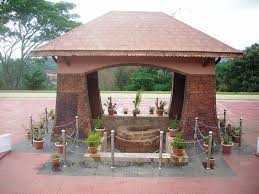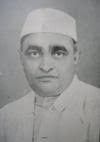
#PazhassiRaja
How Many Bharatiya’s Are Aware Of The Fact That Arthur Wellesely, Duke of Wellington Adopted Methods Of Guerrilla Warfare Used By Pazhassi Raja To Defeat Napoleon's Armies In Spain?
Whereas Left & Congress Distorians Sang The Bravery and Valour Of Mughals & Muslim

How Many Bharatiya’s Are Aware Of The Fact That Arthur Wellesely, Duke of Wellington Adopted Methods Of Guerrilla Warfare Used By Pazhassi Raja To Defeat Napoleon's Armies In Spain?
Whereas Left & Congress Distorians Sang The Bravery and Valour Of Mughals & Muslim


Invaders, Showered Petals On Christians For Bringing Light To Otherwise Dark Bharata Khanda, Here Is An Account From British On A Raja Of A Small Kingdom Of Tiny Kerala.
Born on 03rd January 1753 as #KeralaVarma, he was the de facto head of kingdom of Kottayam, Malabar region
Born on 03rd January 1753 as #KeralaVarma, he was the de facto head of kingdom of Kottayam, Malabar region
and is popularly known as Kerala Simham on account of his martial exploits.
When Hyder Ali (Tipu Sultan’s Father) occupied Malabar in 1773, the Raja of Kottayam found political asylum in Kallara near Vikom in Kottayam district of Kerala. Pazhassi Raja, the fourth prince in line
When Hyder Ali (Tipu Sultan’s Father) occupied Malabar in 1773, the Raja of Kottayam found political asylum in Kallara near Vikom in Kottayam district of Kerala. Pazhassi Raja, the fourth prince in line
for succession to the throne during this period, became one of the de facto heads of state, surpassing several older royal contenders. He fought a war of resistance against the Mysorean army from 1774 to 1793. On account of his refusal to flee and due to his effective resistance
to Mysoreans, he gained firm support of his subjects.
In 1792, after the Third Anglo-Mysore War, the East India Company imposed control in Kottayam in violation of an earlier agreement of 1790 which had recognised its independence. Vira Varma, to whom Raja was a nephew, was
In 1792, after the Third Anglo-Mysore War, the East India Company imposed control in Kottayam in violation of an earlier agreement of 1790 which had recognised its independence. Vira Varma, to whom Raja was a nephew, was
appointed by the East India Company authorities as the Raja of Kottayam. To meet revenue targets fixed by Company authorities, Vira Varma ordered an exorbitant tax to be collected from the peasantry and this move was met in 1793 by a mass resistance led by Pazhassi Raja, who had
always been opposed to the Company's rule. In 1796, the Company made an attempt to arrest Pazhassi Raja, but he evaded capture and instead fought back using guerilla warfare. After a string of serious setbacks, the Company sued for peace in 1797. The conflict was renewed in 1800
over a dispute on Wayanad and after a five-year-long war of insurgency, Pazhassi Raja was killed on 30 November 1805 in a gun-fight at Mavila Thodu (small body of water), in the present day Kerala-Karnataka border.
The British have recorded that the wounded Raja did live long

The British have recorded that the wounded Raja did live long


enough for a few more minutes to raise his loaded gun and then tell Canara Menon, an East India Company minor official, not to come too close to his dying body and pollute it.
Raja's contempt and sarcasm for a man who chose to serve unclean foreigner are evident. But it also
Raja's contempt and sarcasm for a man who chose to serve unclean foreigner are evident. But it also
showed his uncompromising stand towards collaborators and foreign invaders.
Kunjani, the wife of Raja who was taken the prisoner, committed suicide in captivity at Kappanaveedu, near Thalassery. As reprisal on his family, property was confiscated and the palace at Pazhassi was
Kunjani, the wife of Raja who was taken the prisoner, committed suicide in captivity at Kappanaveedu, near Thalassery. As reprisal on his family, property was confiscated and the palace at Pazhassi was
demolished
The British recorded their assessment on Kerala Varma and listed below are a few...
1)But in all classes, I observed a decided interest for the Pyche Raja, towards whom the inhabitants entertained regard and respect bordering on veneration, which not even his death
The British recorded their assessment on Kerala Varma and listed below are a few...
1)But in all classes, I observed a decided interest for the Pyche Raja, towards whom the inhabitants entertained regard and respect bordering on veneration, which not even his death
can efface.
— Thomas Harvey Baber, 1805
2)Walter Ivor, a member of Court of Directors, who had taken part in negotiations with Pazhassi Raja in 1797 notes that British losses that year in Kottayam War exceeded British losses in Third Anglo-Mysore War.(Against Tipu)
— Thomas Harvey Baber, 1805
2)Walter Ivor, a member of Court of Directors, who had taken part in negotiations with Pazhassi Raja in 1797 notes that British losses that year in Kottayam War exceeded British losses in Third Anglo-Mysore War.(Against Tipu)
3)British military command always wondered at the logistics of Raja's army. How he organized supplies for his several thousand strong armies remained a puzzle for them.
4)To fight overwhelmingly superior enemies, Raja imparted military training to his peasantry wholesale and
4)To fight overwhelmingly superior enemies, Raja imparted military training to his peasantry wholesale and
recruited them into his military force. This military policy of wholesale militarization was novel in the history of pre-modern Kerala. His war-effort was marked by the participation of members of all creeds, classes, and castes who took up arms due to his inspiration. Nobles,
headmen, peasants, shopkeepers, merchants, artisans, and forest tribes rallied to fight the foreign invaders — first Mysore and later English East India Company.
5)British losses were severe in terms of men and ran into several thousand. Death toll was particularly high with
5)British losses were severe in terms of men and ran into several thousand. Death toll was particularly high with
officers of commissioned ranks. So high were the losses suffered by Bombay army regiments that operated in North Malabar that they had to be withdrawn in 1803 fearing that further losses would cripple Bombay Army as a respectable body of troops.
6)Raja shared all the privations
6)Raja shared all the privations
of his ordinary soldiers during the war and took part in all major military action exposing himself to personal danger. On account of these attributes, he commanded great respect of his troops.
7)Royal regiments from Britain also took part in Cotiote War along with Company
7)Royal regiments from Britain also took part in Cotiote War along with Company
troops.
8)Arthur Wellesely, Duke of Wellington adopted methods of guerrilla warfare used by Pazhassi Raja to defeat Napoleon's armies in Spain
9)A British agent had noted as early as 1797 that extreme popularity of Raja was on account of the fact that he remained in his country
8)Arthur Wellesely, Duke of Wellington adopted methods of guerrilla warfare used by Pazhassi Raja to defeat Napoleon's armies in Spain
9)A British agent had noted as early as 1797 that extreme popularity of Raja was on account of the fact that he remained in his country
with his subjects during Mysore invasions and shared with them the trials and tribulations and also due to his extreme generosity to this peasantry. It was on account of love and support from his subjects that Raja could evade and fight British for a decade even when he had a
bounty on his head.
10)After his fellow Rajas in Malabar submitted to British after 1798, Raja himself knew well that he will be defeated and killed in the long run if he chose to fight English East India Company. But yet he refused to compromise. In a letter to Kalyat
10)After his fellow Rajas in Malabar submitted to British after 1798, Raja himself knew well that he will be defeated and killed in the long run if he chose to fight English East India Company. But yet he refused to compromise. In a letter to Kalyat
Kuttieman, he reveals his intent to resist English power to the end.
He took initiative to rebuild his country which was devastated by Mysore invasions. As part of this, he borrowed money from Tellicherry Factory and gave financial help to his peasants to resume agriculture
He took initiative to rebuild his country which was devastated by Mysore invasions. As part of this, he borrowed money from Tellicherry Factory and gave financial help to his peasants to resume agriculture
along with distribution of seeds and cattle. This was in contrast to rest of Rajas of Malabar who squeezed peasants. This was one reason why his popularity with masses remained high.
12)Raja is also credited with the spread of agriculture in Wynad. He started a program that
12)Raja is also credited with the spread of agriculture in Wynad. He started a program that
encouraged tribesmen in Wynad to adopt settled agriculture. As part of this program, he instructed his vassals in Wynad to distribute cattle and seeds to tribesmen in Wynad.
The Left & Congress Politicians Ruling Kerala Since Independence Must Be Ashamed For Keeping
The Left & Congress Politicians Ruling Kerala Since Independence Must Be Ashamed For Keeping
• • •
Missing some Tweet in this thread? You can try to
force a refresh
















